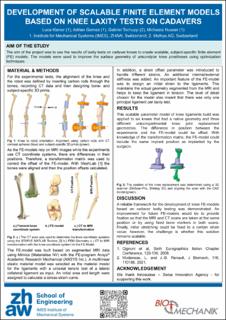Please use this identifier to cite or link to this item:
https://doi.org/10.21256/zhaw-28440| Publication type: | Conference poster |
| Type of review: | Peer review (abstract) |
| Title: | Development of scalable finite element models based on knee laxity tests on cadavers |
| Authors: | Kiener, Luca Gomez, Adrian Tschupp, Gabriel Nusser, Michaela |
| et. al: | No |
| DOI: | 10.21256/zhaw-28440 |
| Conference details: | 28th Congress of the European Society of Biomechanics (ESB), Maastricht, The Netherlands, 9 -12 July 2023 |
| Issue Date: | Jul-2023 |
| Publisher / Ed. Institution: | ZHAW Zürcher Hochschule für Angewandte Wissenschaften |
| Language: | English |
| Subjects: | Scalable parameter model of knee ligaments; FEM; Validated |
| Subject (DDC): | 571: Physiology and related subjects 610.28: Biomedicine, biomedical engineering |
| Abstract: | Aim of the study: The aim of the project was to use the results of laxity tests on cadaver knees to create scalable, subject-specific finite element (FE) models. The models were used to improve the surface geometry of unicondylar knee prostheses using optimization techniques. Material and methods: For the experimental tests, the alignment of the knee and the robot was defined by inserting carbon rods through the bones, recording CT data and then designing bone- and subject-specific 3D prints. As the FE-models rely on MRI images while the experiments use CT coordinate systems, there are differences in their positions. Therefore, a transformation matrix was used to correct the offset of the FE-model. With MeshLab the bones were aligned and then the position offsets calculated. The FE-model was built based on segmented MRI data using Mimics (Materialise NV) with the FE-program Ansys® Academic Research Mechanical (ANSYS Inc.). A multilinear elastic material model was selected as the material model for the ligaments with a uniaxial tensile test of a lateral collateral ligament as input. An initial area and length were assigned to calculate a stress-strain curve. In addition, a strain offset parameter was introduced to handle different strains. An additional internal/external stiffness was added. An important feature of the FE-model was to assign an initial strain to the ligaments. This maintains the actual geometry segmented from the MRI and helps to keep the ligament in tension. The level of detail chosen for the model also meant that there was only one principal ligament per laxity test. Results: This scalable parameter model of knee ligaments build was applied to six knees that had a native geometry and three different unicompartmental knee joint replacement geometries. The difference in position between the experiments and the FE-model could be offset. With knowledge of the transformation matrix, the FE-model could include the same implant position as implanted by the surgeon. Discussion: A reliable framework for the development of knee FE-models based on cadaver laxity testing was demonstrated. An improvement for future FE-models would be to provide fixation so that the MRI and CT scans are taken at the same position or by using fixed bone markers in both scans. Finally, initial stretching could be fixed to a certain strain value; however, the challenge is whether this solution remains scalable. |
| URI: | https://digitalcollection.zhaw.ch/handle/11475/28440 |
| Fulltext version: | Published version |
| License (according to publishing contract): | Licence according to publishing contract |
| Departement: | School of Engineering |
| Organisational Unit: | Institute of Mechanical Systems (IMES) |
| Published as part of the ZHAW project: | Entwicklung einer unikondylären Kniegelenksprothese mit physiologischer Kinematik |
| Appears in collections: | Publikationen School of Engineering |
Files in This Item:
| File | Description | Size | Format | |
|---|---|---|---|---|
| 2023_Kiener-etal_ESB2023-Poster.pdf | 261.6 kB | Adobe PDF |  View/Open |
Show full item record
Kiener, L., Gomez, A., Tschupp, G., & Nusser, M. (2023, July). Development of scalable finite element models based on knee laxity tests on cadavers. 28th Congress of the European Society of Biomechanics (ESB), Maastricht, the Netherlands, 9 -12 July 2023. https://doi.org/10.21256/zhaw-28440
Kiener, L. et al. (2023) ‘Development of scalable finite element models based on knee laxity tests on cadavers’, in 28th Congress of the European Society of Biomechanics (ESB), Maastricht, The Netherlands, 9 -12 July 2023. ZHAW Zürcher Hochschule für Angewandte Wissenschaften. Available at: https://doi.org/10.21256/zhaw-28440.
L. Kiener, A. Gomez, G. Tschupp, and M. Nusser, “Development of scalable finite element models based on knee laxity tests on cadavers,” in 28th Congress of the European Society of Biomechanics (ESB), Maastricht, The Netherlands, 9 -12 July 2023, Jul. 2023. doi: 10.21256/zhaw-28440.
KIENER, Luca, Adrian GOMEZ, Gabriel TSCHUPP und Michaela NUSSER, 2023. Development of scalable finite element models based on knee laxity tests on cadavers. In: 28th Congress of the European Society of Biomechanics (ESB), Maastricht, The Netherlands, 9 -12 July 2023. Conference poster. ZHAW Zürcher Hochschule für Angewandte Wissenschaften. Juli 2023
Kiener, Luca, Adrian Gomez, Gabriel Tschupp, and Michaela Nusser. 2023. “Development of Scalable Finite Element Models Based on Knee Laxity Tests on Cadavers.” Conference poster. In 28th Congress of the European Society of Biomechanics (ESB), Maastricht, the Netherlands, 9 -12 July 2023. ZHAW Zürcher Hochschule für Angewandte Wissenschaften. https://doi.org/10.21256/zhaw-28440.
Kiener, Luca, et al. “Development of Scalable Finite Element Models Based on Knee Laxity Tests on Cadavers.” 28th Congress of the European Society of Biomechanics (ESB), Maastricht, the Netherlands, 9 -12 July 2023, ZHAW Zürcher Hochschule für Angewandte Wissenschaften, 2023, https://doi.org/10.21256/zhaw-28440.
Items in DSpace are protected by copyright, with all rights reserved, unless otherwise indicated.